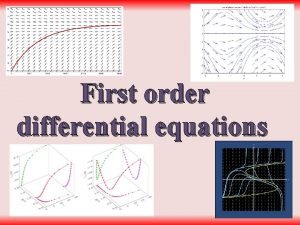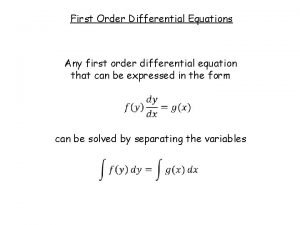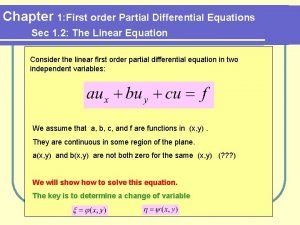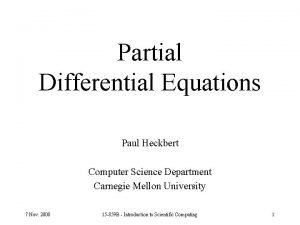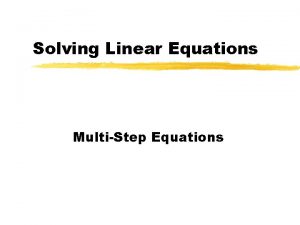Specialist Mathematics Solving differential equations DEs Solving differential













- Slides: 13

Specialist Mathematics Solving differential equations (DEs).

Solving differential equations › Verifying solutions. › First and second order when dy/dx is the function of x. › First order when dy/dx is the function of y. › By separation of variables. › Using CAS. › Applications with DEs. Sketching slope fields and Euler’s method for numerical solutions of DEs.

General solution versus particular solution. Example: Find the general solution to general solution Particular solution requires boundary conditions. Example: Solve passes through (2, 0). given that the solution curve particular solution

Classification of differential equations (DEs). THE ORDER OF EQUATION THE DEGREE OF EQUATION › The highest derivative order that appears in a DE is called the order of the equation. › The highest power of a DE gives the degree. is a first order DE is a second order DE is a third order DE Linear and non-linear DEs.

Definitions and Terms A differential equation (diff. eq. , DE) is an equation that involves x, y, and some derivatives of y. These are called ordinary differential equations (ODEs) because y is a function of only x.

Verifying solutions. https: //www. youtube. com/watch? v=p. AGFdf 2 t. Krc

Real life applications. • Population growth / decay, where rate of change of population is proportional to the population at any time. • Newton’s Law of cooling – rate of change of temperature is proportional to the excess of the temperature above its surroundings. • Salt solutions type questions. • Rates in and rates out in a container. • DEs with related rates.

Ex 1. Verify that the given function is a solution to the given DE. DE Function Find dy/dx first Substitue back into the given DE Simpilfy LHS=RHS, verified. true so

Ex 2. Verify that the given function is a solution to the given DE. Notice that y = 0 is a solution to both DEs. This is called the trivial solution.

Ex 3. Find values for m that would make y = emx a solution of the DE 2 y + 7 y – 4 y = 0.

Practice Problem Verify that the DE is a solution to

Question 6 p 372

Ex 9 A p 372 Questions 1 a, 2 c, d, e, g, 2 c, g, 3, 4, 5, 7
 5 big ideas maths mastery
5 big ideas maths mastery Solving 1st order differential equations
Solving 1st order differential equations Integrating factor of differential equation
Integrating factor of differential equation Solving 1st order differential equations
Solving 1st order differential equations Des des des
Des des des Topic 3 the mathematics of formulas and equations
Topic 3 the mathematics of formulas and equations Differential equations projects
Differential equations projects Formation of partial differential equations ppt
Formation of partial differential equations ppt Paul heckbert
Paul heckbert Cengage differential equations
Cengage differential equations First order differential equations
First order differential equations Adam moulton method
Adam moulton method Define differential equation
Define differential equation Differentiation equation examples
Differentiation equation examples

